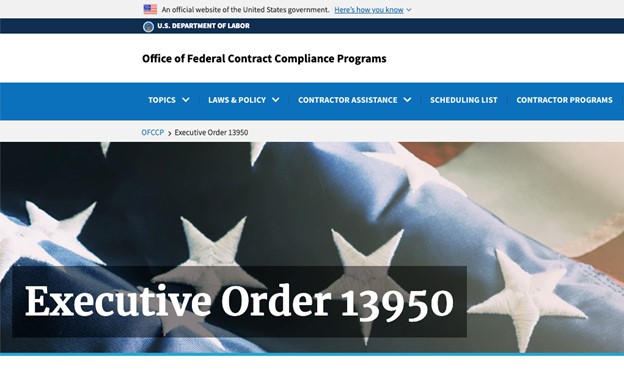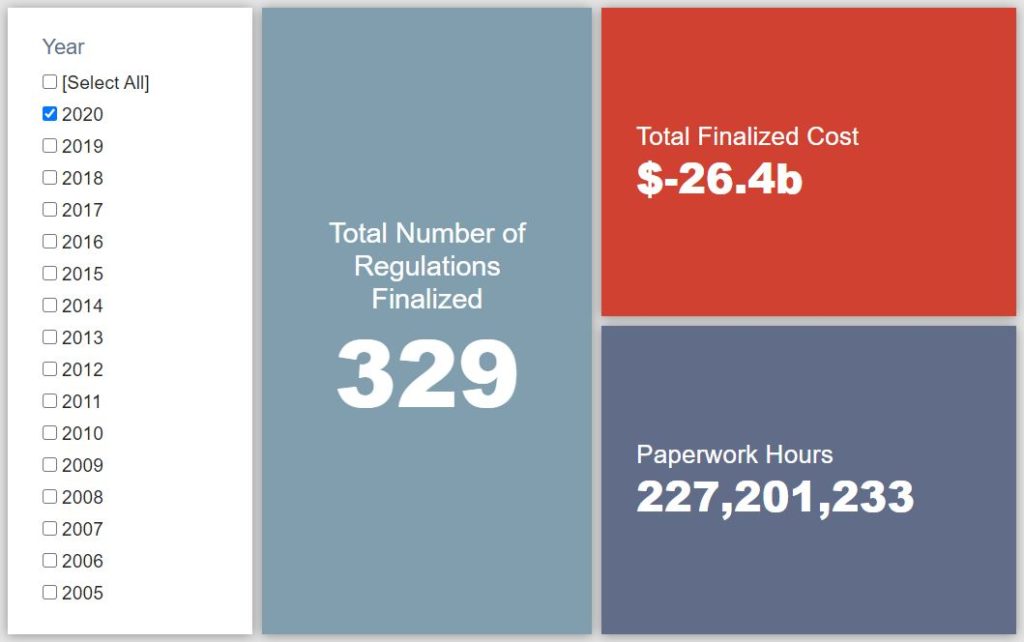Week in Regulation
October 26, 2020
An October Break in Action
For the past month or so, week after week had seen regulations with billions of dollars in either costs or cost reductions. This past week brought a respite from such incredible swings. Of the five rulemakings with some measurable economic impact, none had a cost or savings estimate beyond a few million dollars. Across all rulemakings, agencies published $7.5 million in total net cost savings but added 294,680 hours of annual paperwork.
REGULATORY TOPLINES
- Proposed Rules: 37
- Final Rules: 62
- 2020 Total Pages: 67,547
- 2020 Final Rule Costs: -$26.4 billion
- 2020 Proposed Rule Costs: $15.7 billion
TRACKING THE REGULATORY BUDGET
There were no final rules with a measurable impact that could apply to the fiscal year (FY) 2021 regulatory budget. The only rulemaking that could eventually contribute to the current budgetary window was a proposed rule regarding “Federal Acquisition Regulation: Application of Micro-Purchase Threshold To Task and Delivery Orders.” The proposal would adjust the threshold of “micro-purchases” and thus “reduce costs to submit an offer for the unsuccessful awardees who participate” in the bidding process. The estimated savings, however, are relatively modest: roughly $200,000 annually or $3.8 million in present value.
While the administration’s FY 2021 regulatory budget caps are still forthcoming, so far this fiscal year agencies have officially published 12 deregulatory actions and 4 regulatory actions, totaling $2.2 billion in quantified total net costs. The American Action Forum’s review of the administration’s FY 2020 regulatory budget progress can be found here.
THIS WEEK’S REGULATORY PICTURE
This week, the Department of Labor (DOL) begins implementing a recent executive order on alleged “race or sex stereotyping or scapegoating.”

Source: https://www.dol.gov/agencies/ofccp/executive-order-13950
On October 21 the DOL’s Office of Contractor Compliance Programs (OFCCP) released the first steps of its directive from Executive Order (EO) 13,950. That EO, titled “Combating Race and Sex Stereotyping,” establishes the “policy of the United States not to promote race or sex stereotyping or scapegoating in the Federal workforce or in the Uniformed Services, and not to allow grant funds to be used for these purposes.”
The EO specifically prohibits federal contractors from using workplace trainings that teach employees about racial biases that might be interpreted as suggesting people are inherently racist or that fundamental racism exists in the United States. It offers no empirical evidence that trainings currently do that, instead listing three anecdotes of materials at federal agencies it says are “contrary to the fundamental premises underpinning our Republic.”
The OFCCP this week launched a hotline and email address where people can lodge complaints about federal contractor bias training. It also published a request for information asking for the public to submit materials from racial or sex bias trainings that they find problematic. Further requirements of the EO will require contractors to submit to federal agencies materials related to trainings, which will be onerous and time consuming.
The EO, and subsequent implementation, appears to be more politically motivated than tethered to reality. Last week, data obtained from a Freedom of Information Act request showed that the Department of Veterans Affairs is twice as likely to promote white employees over black employees, suggesting the federal government has substantial work to do to deal with its own biases.
TOTAL BURDENS
Since January 1, the federal government has published $10.8 billion in total net cost savings (with $26.4 billion from finalized rules) and 279.3 million hours of net annual paperwork burden increases (with 227.2 million hours due to final rules). Click here for the latest Reg Rodeo findings.












